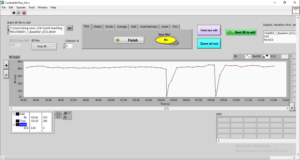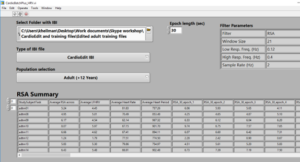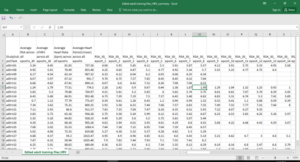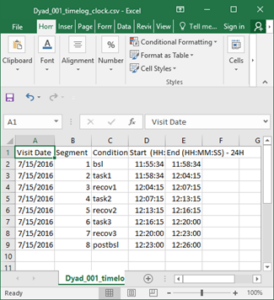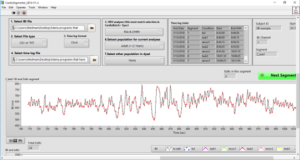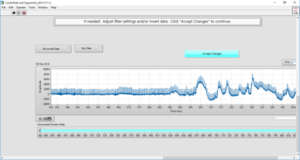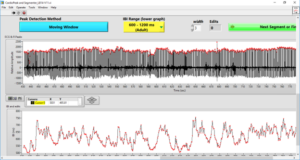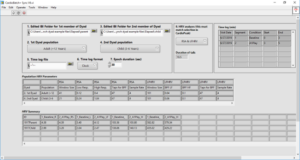Training Workshops for Editing and Analyses of Cardiac Rhythms
CardioEdit Plus and CardioBatch Plus are Windows-based programs designed for the editing and analyses of cardiac rhythms. The programs functionally replace the previous DOS-based program, MXedit. While we do not currently offer a Mac-version of the programs, the programs are compatible with a Windows-emulator that is installed on a Mac.
We now offer virtual training workshops on the use of the programs. To ensure reliability of editing procedures, the programs are only released to researchers who attend our training workshops. While the programs are intuitive and easy to use, the purpose of the workshops is to highlight the features of the programs and to provide assistance with data editing techniques and strategies for editing artifacts and arrhythmias. Although we encourage multiple attendees from the same research group to attend the workshop (at no additional charge), only one representative from a research group is required to attend the workshop in order to acquire the programs.
Workshop attendees are provided with 20 self-guided training files, with separate training files for infants and for children/adults. These files provide experience with data editing and use of the programs. Following successful completion of the training files, attendees are encouraged to complete the reliability files to achieve CardioEdit Plus certification. The duration of the CardioEdit Plus/CardioBatch Plus Training Workshop is approximately 4 hours, and cost includes hands-on training, laboratory license for the programs, instructional manual, off-line evaluation, and certification of reliability training.
The workshops are conducted by Keri J. Heilman, PhD., who has been working with Dr. Porges since 2000 and conducting workshops since 2005. Workshops are scheduled per request. Please send email request to Dr Heilman at keri_heilman@med.unc.edu for inquiries about cost and individualized software packages based on your equipment and protocol. For information about software updates for previous users of CardioEdit and/or CardioBatch, please contact Dr Heilman.
Available software:
CardioEdit Plus
CardioEdit Plus is used for visual inspection and editing of IBI data (also known as inter-beat interval or R-R interval), with the option to review and correct the accuracy of R-peak detection using the underlying ECG.
CardioBatch Plus
CardioBatch Plus is used to analyze the IBI data for the following output variables: Heart rate, Heart period, and Heart rate variability, including Respiratory sinus arrhythmia (RSA) and Low-frequency HRV. CardioBatch Plus output (.csv format which is easy to import into statistical software) includes output variables per epoch within conditions and the average of epochs across conditions. Start/end times for each condition (i.e., baseline, task) can be designated using our compatible Digital Timelog software.
Digital Timelog
The Digital Timelog allows you to record start/end times for each of our conditions as you are recording data. The output file is automatically formatted for use in CardioSegmenter or CardioPeak and Segmenter software.
CardioSegmenter
CardioSegmenter is used for files that contain IBI data only (no ECG). The program will segment your IBI data into the conditions you specify in your Digital Timelog, and save them as separate files that are now formatted for CardioEdit Plus.
CardioPeak and Segmenter
CardioPeak and Segmenter is used for files that contain ECG or pulse data from which IBI data need to be extracted for editing and analyses. CardioPeak and Segmenter Software serves as a (1) signal filter; (2) an R-peak detector; and (3) a segmenter.
- Filter to optimize ECG signal: To optimize peak detection, filters are available to allow the user to optimize the ECG/pulse signal prior to applying the peak detector.
Before filtering:
After filtering:
- R-peak detector: The program offers 2 different methods of peak detection (Threshold and Moving Window), which gives the user the option to select the best peak detector for each condition of data. To assist the user with selection of peak detection method, the program also provides an “estimated number of edits” needed when applying either method of peak-detection.
- Moving Window peak-detector (3 settings available: infant, child/adolescent, adult IBI range):
- Threshold detector:
- Segmenter: By uploading a Digital Timelog along with your data file, the program will allow the user to review each condition of data individually and will provide separate IBI and ECG output files for each condition (i.e., baseline, task, etc.). The output files can be easily uploaded into CardioEdit Plus for artifact review and editing.
Below is a list of output files after running CardioPeak and Segmenter:
CardioBatch Plus Synchrony
CardioBatch Plus Synchrony is designed for users who want to synchronize data output between 2 or more participants of different age groups (i.e., parent-infant). This software standardizes the re-sampling rate between the participants, while still allowing appropriate filter parameters to be applied to each participant. Appropriate settings must be applied in CardioPeak and Segmenter software when using CardioBatch Plus Synchrony software. CSV output file includes synchronized RSA, LFHRV, heart period and heart rate.
References
For use of CardioSegmenter software, the following citation is required:
CardioSegmenter software. Brain-Body Center for Psychophysiology and Bioengineering, University of North Carolina, Chapel Hill. 2020.
For use of CardioPeak and Segmenter software, the following citation is required:
CardioPeak and Segmenter software. Brain-Body Center for Psychophysiology and Bioengineering, University of North Carolina, Chapel Hill. 2019.
For use of CardioEdit Plus software, the following citation is required:
CardioEdit Plus software. Brain-Body Center for Psychophysiology and Bioengineering, University of North Carolina, Chapel Hill. 2022.
For use of CardioBatch Plus software, the following citation is required:
CardioBatch Plus software. Brain-Body Center for Psychophysiology and Bioengineering, University of North Carolina, Chapel Hill. 2016.
For use of CardioBatch Plus Synchrony software, the following citation is required:
CardioBatch Plus Synchrony software. Brain-Body Center for Psychophysiology and Bioengineering, University of North Carolina, Chapel Hill. 2019.
For analyses derived from CardioBatch Plus or CardioBatch Plus Synchrony, additional citations are required:
Porges, S.W. Method and Apparatus for Evaluating Rhythmic Oscillations in Aperiodic Physiological Response Systems. Patent Number: 4,510,944. Washington DC: U.S. Patent Office. April 16, 1985.
Porges, S.W., & Bohrer, R.E. (1990). Analyses of periodic processes in psychophysiological research. In J.T. Cacioppo and L.G. Tassinary (eds.), Principles of Psychophysiology: Physical, Social, and Inferential Elements. New York: Cambridge University Press, 708-753.
Porges, S.W. Systems and Methods for Modulating Physiological State. Patent Number 10,702,154. Washington DC: U.S. Patent Office. July 7, 2020.

